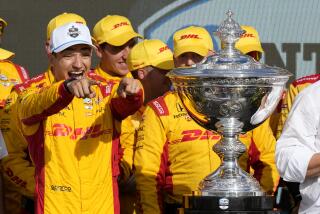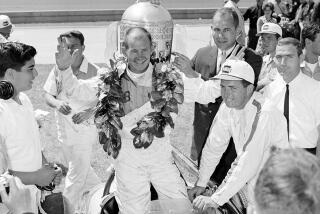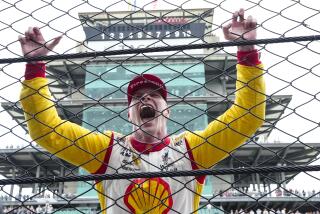They Won’t Move Out of Fast Lane
With 17 crashes--one fatal--before they even dropped the green flag to start the race, then 10 more before they dropped the checkered flag to end it, Indianapolis has to be understandably uneasy about the future of the 500.
Are they, finally, going too fast? Is a track where, when you get four cars abreast, 400,000 people come to their feet and mouth “Oooooh!” in unison, too narrow? Are concrete walls the best option to keep the cars on the track and not in the seats?
One hates to turn back the clock in any sport, indeed, in any human endeavor. It’s a form of censorship. A stifling of the human spirit.
But at 232 m.p.h., is that driver merely a piece of human flotsam as little in control of his destiny as a feather on a tidal wave? What is the upper limit for ground speed? At what r.p.m. is the brain left in arrears?
The late Eddie Sachs told me almost 30 years ago, “The cars are going faster than you can think.” And that was when they were barely averaging 140. What would Eddie think of cars almost 100 m.p.h. faster?
Of course, speed is relative. Seventy-five m.p.h. in 1911 was probably a lot more dangerous than 230 is today.
But there must be a limit at which the ordinary artifices of man--reflexes, decision-making, comprehending the situation--are no longer adequate. Computer technology has heightened the ability to cope. But no one wants to see a 500-mile race run by microchips or robots with lasers.
Calculating the upper limits in any sport is risky. We thought 10 seconds was as fast as man could cover 100 meters of ground--till Carl Lewis did it in 9.99. We thought 15 feet was the upper limit for the pole vault--and then came the invention of the fiberglass pole and Sergei Bubka is doing 20. No one thought you could run the mile under 4 minutes--till Roger Bannister did it and then everybody began to do it.
The point is, it’s loathsome to put an arbitrary, artificial barrier on achievement. What if they had told the Wright brothers that government safety codes prohibited citizens from leaving the ground? For their own safety.
The carnage of the 76th Indy 500 was fearful--exploding cars, parts flying off in every direction, the sky filled with spinning tires. Tires have killed almost as many people at Indy as walls.
The odd thing is, if you took a vote of the field, the count against imposing a speed limit would be 33-0 against. Drivers, to a man, are convinced that the worst thing you can ever do in life is slow down. It’s bad luck.
Take Eddie Cheever. Eddie, as No. 2 in the front row, inherited the pole when the pole sitter Roberto Guerrero spun out on a parade lap. But as he hit Turn 1 at the race start, the Andretti family went by him like a shot, sandwiching him back to third at once. Michael went below him, Mario went topside and they shuffled him back in the pack.
Says Cheever: “I was thinking, ‘Hey! This race is 200 laps, not 10. What’s the hurry?’ But I found out. Next time, I won’t let it happen.”
Cheever didn’t lose the race in Lap 1. He lost in the last half of the race when the ultimate winner, Al Unser Jr., spotted him passing cars under the yellow light, called in, reported him--and Cheever was penalized a lap. Later, a review showed he had been waved ahead by drivers John Andretti and Raul Boesel and his lap was restored, but the penalty affected his late-lap driving.
The moral is, whether it’s Lap 1 or 199, a race driver likes full boost. Safety hedges seem to fall into place of their own accord. In 1961, an Aussie, Jack Brabham came to the Speedway with an underpowered 167.6-cubic inch engine in an underweight car, pitting 92 horsepower against the 750-horsepower Novi engines. He got blown off in the straights but made up for it in the corners and finished ninth.
The lesson was not lost on Indy, which went to the rear engines a few years thereafter. Safety was a winner as well as engineering. But it wasn’t legislated, it evolved. This year, cars going 228-232 m.p.h. went through the corners as fast as on the straights.
The Slaughter on 16th Street was nonstop this year, but the guys who have to drive through it wouldn’t change it for the world. Put governors on their cars? Would you make Jose Canseco bat left-handed? Make John Daly drive with a four-wood? Have Pavarotti sing rap? Not!
Cars are supposed to race, they tell you. The name of the game is let ‘er rip. Don’t change Indy into the Memorial Day Economy Run.
More to Read
Go beyond the scoreboard
Get the latest on L.A.'s teams in the daily Sports Report newsletter.
You may occasionally receive promotional content from the Los Angeles Times.










